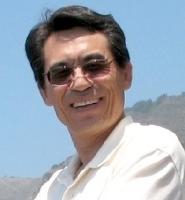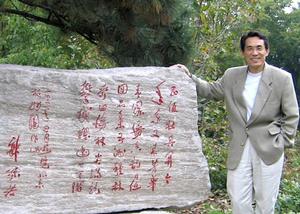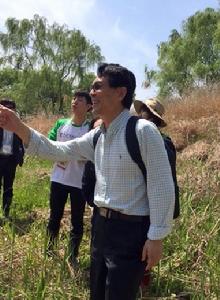現任職務
 鄔建國教授
鄔建國教授(1)美國 亞利桑那州立大學 生命科學學院和全球可持續科學研究所 院長特聘教授
(2)北京師範大學人與環境系統可持續性科學研究中心 創始主任
(3中美生態、能源及可持續性科學內蒙古研究中心 創始主任
(4)國際《景觀生態學》(Landscape Ecology)主編
人物生平
鄔建國於1982年1月畢業於內蒙古大學生態學專業(中國第一個生態學專業),獲學士學位(七七級) 。畢業後留校任教,成為著名草地生態學家李博院士的在職碩士研究生。1985年赴美國加利福利亞大學戴維斯校區訪學,1987年在美國邁阿密大學獲得生態學碩士學位,1991年在美國邁阿密大學獲得生態學博士學位。1991-1993年,獲美國科學基金委員會博士後基金,在康奈爾大學和普林斯頓大學從事研究。1993-1995年在內布拉斯加大學和內華達大學荒漠研究所做助教授。1995至今,在亞利桑那州立大學受聘為助教授,副教授(1999),正教授(2005),和院長特聘教授(2008)。2003-2010年為該校校長辦公室中國項目顧問。是該校全球可持續科學研究所和可持續科學學院的創始教授之一。
研究領域
 鄔建國教授
鄔建國教授研究領域包括景觀生態學、城市生態學、生物多樣性和可持續性 科學。發表論文約300篇,著作14部。其論著和文章在景觀生態學、城市生態學和可持續性科學諸領域影響尤為廣泛 。
除了在美國的研究,鄔建國教授從20世紀90年代以來一直和國內學者進行合作研究,並聯合培養研究生 。研究領域包括內蒙古草原生態和可持續性 ,東北虎種群動態,千島湖生境破碎化和生物多樣性,中國城市化及其環境影響,以及可持續科學的理論和實踐 。
成就榮譽
 鄔建國教授
鄔建國教授鄔建國教授發表論文300餘篇,著作14餘部 。自2005年始擔任國際景觀生態學主流刊 物《景觀生態學》(Landscape Ecology)主編,以及Ecological Economics, Landscape and Ecological Engineering,Frontiers of Energy and Power Engineering in China, Research Letters in Ecology, Journal of Plant Ecology, Peer J , Sustainability ,《生態學報》、《植物生態學報》、《生物多樣性》、《套用生態學報》 和《生態學雜誌》等雜誌的編委。曾擔任美國生態學會亞洲分會主席(1999-2000),美國景觀生態學會學術年會主席(2001),美國生態系統現狀評估項目特邀學者(The H. John Heinz III Center, 2000),IGBP研究計GCTE 項目Task 2.1.4研究組負責人(1997-2002),入選美國名人錄(Who's Who in America)第54版(2000-)。擔任美國景觀生態學會常務理事(2001-2004),美國環境保護部生態學項目科學顧問(2004-2005)。
 鄔建國教授
鄔建國教授2006年獲美國科學促進會(American Association for the Advancement of Science - AAAS)“傑出國際合作獎”。2007年被選為美國科學促進會會士 (AAA Fellow)。2009年美國Leopold Leadership Fellow。2010年獲美國景觀生態學會 “傑出景觀生態學家獎”(Distinguished Landscape Ecologist Award)。2011年獲國際景觀生態學會“傑出科學成就家獎”(Outstanding Scientific Achievements Award)。2012年獲內蒙古自治區“國際科學技術合作獎” 。
中國國家傑出青年科學基金B類獲得者(2001年),中國科學院“百人計畫”國外傑出人才(2003-2005年);國家973項目首席科學家(2014.1-2018.12);北京師範大學985平台特聘教授(2005-2009),浙江大學光彪教授(2006-2009),中國科學院植物研究所特聘兼職研究員(2007-2010),內蒙古大學特聘教授(2008-2012),內蒙古農業大學特聘教授(2006-2011);北京大學、清華大學、中國科學院研究生院、華東師範大學和寧夏大學客座教授。《現代生態學講座系列》學術委員會主任。兼任中美生態、能源及可持續性科學內蒙古研究中心主任 。
外界評價
美國亞利桑那州立大學生命科學學院及全球可持續性科學研究所特聘傑出教授,景觀生態學和可持續發展科學家。
主要學術成果
英文代表作
•Wu,J. 2017. Seascape ecology and landscape ecology: Distinct, related, and synergistic. In: Simon J. Pittman (editor), Seascape Ecology. (in press)
•Forman, R.T.T. and J. G. Wu. 2016. Where to put the next billion people. Nature 537:608-611.
•Ma, Q., J. Wu, and C. He. 2016. A hierarchical analysis of the relationship between urban impervious surfaces and land surface temperatures: spatial scale dependence, temporal variations, and bioclimatic modulation. Landscape Ecology 31:1139-1153.
•Wu, J., Q. Zhang, A. Li, and C. Liang. 2015. Historical landscape dynamics of Inner Mongolia: patterns, drivers, and impacts. Landscape Ecology 30:1579-1598.
•Wu, J., S. Naeem, J. Elser, Y. Bai, J. Huang, L. Kang, Q. Pan, Q. Wang, S. Hao, and X. Han. 2015. Testing biodiversity-ecosystem functioning relationship in the world’s largest grassland: overview of the IMGRE project. Landscape Ecology 30:1723-1736.
•Huang, L., J. Wu, and L. Yan. 2015. Defining and measuring urban sustainability: a review of indicators. Landscape Ecology 30:1175-1193.
•Wu, J. 2014. Urban ecology and sustainability: The state-of-the-science and future directions. Landscape and Urban Planning 125:209-221.
•Wu, J., W. Xiang, and J. Zhao. 2014. Urban ecology in China: Historical developments and future directions. Landscape and Urban Planning 125:222–233
•Wu, J. 2013. Landscape sustainability science: Ecosystem services and human well-being in changing landscapes. Landscape Ecology 28:999-1023.
•Wu, J. 2013. Key concepts and research topics in landscape ecology revisited: 30 years after the Allerton Park workshop. Landscape Ecology 28:1-11.
•Wu, J.G. 2012. Landscape ecology. In: R.A. Meyers (ed), Encyclopedia of Sustainability Science and Technology. Springer.
•Wu, J., A. Buyantuyev, G. D. Jenerette, J. Litteral, and W. Shen. 2011. Quantifying spatiotemporal patterns and ecological effects of urbanization: a multiscale landscape approach. Pages 35-53 in: M. Richter and U. Weiland (eds). Applied Urban Ecology: A Global Framework, Blackwell.
•Wu, J., G. D. Jenerette, A. Buyantuyev, and C. L. Redman. 2011. Quantifying spatiotemporal patterns of urbanization: The case of the two fastest growing metropolitan regions in the United States. Ecological Complexity 8:1-8.
•Wu, J. 2010. Landscape of culture and culture of landscape: does landscape ecology need culture? Landscape Ecology 25:1147–1150.
•Wu, J. 2010. Urban sustainability: an inevitable goal of landscape research. Landscape Ecology 25:1-
•Wu, J. 2009. Ecological dynamics in fragmented landscapes. Pages 438-444 In: S. A. Levin (ed.), Princeton Guide to Ecology. Princeton University Press, Princeton.
•Wu, J. 2008. Changing perspectives on biodiversity conservation: from species protection to regional sustainability. Biodiversity Science 16(3):205-213.
•Bai, Y., J. Wu, Q. Xing, Q. Pan, J. Huang, D. Yang, and X. Han. 2008. Aboveground net primary production and rain use efficiency across a broad precipitation gradient on the Mongolia Plateau. Ecology 89: 2140–2153.
•Shen, W., J. Wu, N. Grimm, and D. Hope. 2008. Effects of urbanization-induced environmental changes on ecosystem functioning in the Phoenix metropolitan region, USA. Ecosystems 11:138-155.
•Buyantuyev, A. and J. Wu. 2007. Effects of thematic resolution on landscape pattern analysis. Landscape Ecology 22:7-13.
•Wu, J. 2007. Scale and scaling: A cross-disciplinary perspective. In: J. Wu and R. Hobbs (eds). Key Topics in Landscape Ecology. Cambridge University Press, Cambridge.
•Wu, J. 2006. Cross-disciplinarity, landscape ecology, and sustainability science. Landscape Ecology 21:1-4.
•Wu, J. and H.B. Li. 2006. Concepts of scale and scaling. In: J. Wu, B. Jones, H. Li and O.L. Loucks (eds). Scaling and Uncertainty Analysis in Ecology. Springer, Dordrecht, The Netherlands. pp. 3-15.
•Wu, J. and H.B. Li. 2006. Perspectives and methods in scaling: A review. In: J. Wu, B. Jones, H. Li and O.L. Loucks (eds). Scaling and Uncertainty Analysis in Ecology. Springer, Dordrecht, The Netherlands. pp. 17-44.
•Bai, Y., X. Han, J. Wu, Z. Chen, and L. Li. 2004. Ecosystem stability and compensatory effects in the Inner Mongolia Grassland. Nature 431:181-184.
•Li, H. and J. Wu. 2004. Use and misuse of landscape indices. Landscape Ecology 19: 389-399.
•Wu, J., J. Huang, X. Han, X. Gao, F. He, M. Jiang, Z. Jiang, R. B. Primack, and Z. Shen. 2004. Three Gorges Dam: An Ecological Perspective. Frontiers in Ecology and the Environment 2(5): 241-248.
•Wu, J. 2004. Effects of changing scale on landscape pattern analysis: Scaling relations. Landscape Ecology 19:125-138.
•Wu, J., J. Huang, X. Han, Z. Xie, and X. Gao. 2003. Three-Gorges Dam: The Largest “Natural” Experiment of Habitat Fragmentation? Science 300:1239-1240.
•Wu, J., W. Shen, W. Sun, and P. T. Tueller. 2002. Empirical patterns of the effects of changing scale on landscape metrics. Landscape Ecology17:761-782.
•Wu, J. and R. Hobbs. 2002. Key issues and research priorities in landscape ecology: An idiosyncratic synthesis. Landscape Ecology 17:355-365.
•Luck, M. and J. Wu. 2002. A gradient analysis of the landscape pattern of urbanization in the Phoenix metropolitan area of USA. Landscape Ecology 17:327-339.
•Wu, J. and D. Marceau. 2002. Modeling complex ecological systems: An introduction. Ecological Modelling 153:1-6.
•Wu, J. and J. L. David. 2002. A spatially explicit hierarchical approach to modeling complex ecological systems: Theory and applications. Ecological Modelling 153:7-26.
•Wu, J., D. E. Jelinski, M. Luck and P.T. Tueller. 2000. Multiscale analysis of landscape heterogeneity: Scale variance and pattern metrics. Geographic Information Sciences 6(1):6-19.
•Wu, J. 1999. Hierarchy and scaling: Extrapolating information along a scaling ladder. Canadian Journal of Remote Sensing 25(4): 367-380.
•Wu, J. and S. A. Levin. 1997. A patch-based spatial modeling approach: conceptual framework and simulation scheme. Ecological Modelling 101:325-346.
•Jelinski,D. E. and J. Wu. 1996. The modifiable areal unit problem and implications for landscape ecology. Landscape Ecology 11(3):129-140.
•Qi, Y. and J. Wu. 1996. Effectsof changing scale on the results of landscape patterna nalysis using spatial autocorrelation indices. Landscape Ecology 11(1):39-50.
•Wu, J. and O. L. Loucks. 1995. From balance-of-nature to hierarchical patch dynamics: A paradigm shift in ecology. Quarterly Review of Biology 70:439-466.
•Wu, J. and S. A. Levin. 1994. A spatial patch dynamic modeling approach to patternand process in an annual grassland. Ecological Monographs 64(4):447-464.
•Wu, J., J.L. Vankat and Y. Barlas. 1993. Effects of patch connectivity and arrangement on animal metapopulation dynamics: a simulation study. Ecological Modelling65:221-254.
•Wu, J. and O. L.Loucks. 1992. Xilingele grassland. Pages 67-84 In: The US NationalResearch Council (ed),Grasslands and Grassland Sciences in Northern China.National Academy Press,Washington, D.C.
•Wu, J. andJ. L. Vankat. 1991. A System Dynamics model of island biogeography. Bulletin of Mathematical Biology 53:911-940.
•Wu, J. andJ. L. Vankat. 1991. An area-based model of species richness dynamics of forest islands. Ecological Modelling 58:249-271.
•Wu, J. 1990. Modelling the energy exchange processes between plant communities and environment. Ecological Modelling 51:233-250.
中文代表作
[1]鄔建國,何春陽,張慶雲,於德永,黃甘霖,黃慶旭. 全球變化與區域可持續發展耦合模型及調控對策[J]. 地球科學進展,2014,(12):1315-1324.
[2]鄔建國,郭曉川,楊稢,錢貴霞,牛建明,梁存柱,張慶,李昂. 什麼是可持續性科學?[J]. 套用生態學報,2014,(01):1-11.
[3]鄔建國. 景觀生態學中的十大研究論題[J]. 生態學報,2004,(09):2074-2076.
[4]鄔建國. 景觀生態學——概念與理論[J]. 生態學雜誌,2000,(01):42-52.
[5]鄔建國. Metapopulation(複合種群 )究竟是什麼 ?[J]. 植物生態學報,2000,(01):123-126.
[6]鄔建國. 生態學範式變遷綜論[J]. 生態學報,1996,(05):449-459.
[7]鄔建國. 略談理論和模型在生態學中的作用[J]. 生態學雜誌,1994,(03):76-79+82.
[8]鄔建國. 數學模型與自然保護科學[J]. 套用生態學報,1992,(03):286-288.
[9]鄔建國,李百鍊,伍業鋼. 綴塊性和綴塊動態:Ⅰ.概念與機制[J]. 生態學雜誌,1992,(04):43-47.
[10]鄔建國. 耗散結構、等級系統理論與生態系統[J]. 套用生態學報,1991,(02):181-186.
[11]鄔建國. 島嶼生物地理學理論:模型與套用[J]. 生態學雜誌,1989,(06):34-39.
![鄔建國[生態學家] 鄔建國[生態學家]](/img/5/05d/nBnauM3XyITO0MjNyEDOyUTN1UTM1QDN5MjM5ADMwAjMwUzLxgzLwEzLt92YucmbvRWdo5Cd0FmL0E2LvoDc0RHa.jpg)
